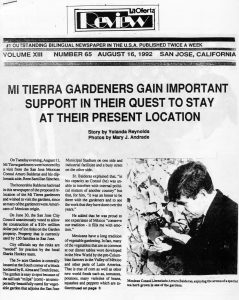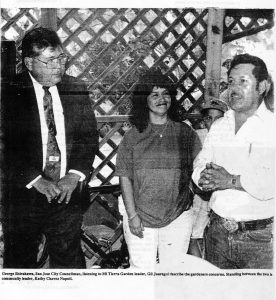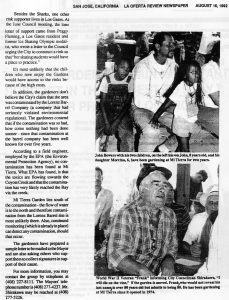August 16, 1992
By Yolanda Reynolds

On Tuesday evening, August 11, Mi Tierra gardeners were honored by a visit from the San Jose Mexican Consul Arturo Balderas and his diplomatic aide, René Santillán Sánchez.
He honorable Balderas had read in this newspaper of the proposed relocation of the Mi Tierra gardeners and wished to visit the gardeners, since so many of the gardeners were Americans of Mexican origin.
On June 30, the San Jose City Council unanimously voted to allow the construction of a $10+ million dollar for an ice rink on the Garden property. Property that is currently used by 150 families in San Jose.
City officials say the rinks are “needed” for practice by the local Sharks Hockey team.
The 5+ acre Garden is centrally located at the south corner of a block bordered by E. Alma and Tenth Street. The garden is easy to spot because of the tall lush “milpa” (corn an unexpectedly beautifully cared for vegetable garden that adjoins the San Jose Municipal Stadium on one side and industrial facilities and a busy street on the other side.
Sr. Balderas explained that, “in his capacity as Consul (he) was unable to interfere with internal political matters of another country” but that, for him, “it was an honor to be there with the gardeners and to see the work that they have done over the years.”
He added that he was proud to see expatriates of Mexico “conserve our tradition – it fills me with emotion.”
Mexicans have a long tradition of vegetable gardening. In fact, many of the vegetables that are so common at our dinner tables were developed in the New World by the pre-Columbian farmers in the Valley of Mexico and other parts of Latin America. That is true of corn as well as other new world foods such as tomatoes, potatoes, many varieties of beans, squashes and peppers which are today served daily in many of our homes.
They also developed the cocoa bean from which chocolate is derived. Chocolate drink was favored by the Aztec royalty – and today chocolate is still very, very popular and used in a great variety of recipes.
In the evolution of humankind, gardening has played a major role and is deeply embedded in the culture and traditions of almost everyone.
Mi Tierra Gardens offer a glimpse of that wholesome tradition. La Oferta has visited the Gardens four times and each visit offers another “adventure.”
Each gardener has a very favorite vegetable or herb for a special recipe – recipes that had been a family tradition.
One gardener, Lisa Y. Vautier, explained that the Garden brought many people together who might not otherwise meet and that, for her and her fellow gardeners, Mi Tierra was a place where she felt comfortable to let her snail children wander off to play. Vautier added she found that they (the gardeners) all helped each other and shared not only vegetables and recipes, but felt a real kinship for each other.
That sense of kinship is striking – it’s hard to pinpoint the exact source but people seem so happy to be there and so very proud of the fruit of their labor in the gardens.
They do have a reason to be proud. The vegetable are organically grown, and the soil, after years of very special care, is very fertile. Not all of the gardeners have been there since the beginning of the Garden.
Any time of the day, garden tenants can and do work in their plot. The Gardens open at around 6:30 a.m. and close at 8:30 p.m. daily. Each year the garden tenants select one of their members to serve as President. This year, Mi Tierra’s President is Ramón Ramos.

Originally garden space was rented only to Veterans but, in time, it was made available to anyone who wanted to garden. The garden membership includes people of all ages, with a wide variety of ethnicities and national origins.
Mi Tierra Garden was the first Community Garden established in San Jose. The Garden was conceived and promoted by Artemio Carranza, now deceased, who at that time, 1975, worked in the community and had contact with many War Veterans. He noticed that the people he met frequently mentioned a yearning to garden.
The realization of Mi Tierra was a community wide endeavor. Besides San Jose’s Parks and Recreation Department, other organizations who helped establish Mi Tierra were the Santa Clara Council on Aging, Food Bank (ES0), San Jose City College, 1st Step Project (a part of a program for Student Academic Learning Experiences, SJSU), the OIinder Neighborhood Association and IBM and other individuals as well.
Since then other community gardens have been established in the City. The gardens are popular and each garden has a long waiting list of others who wish to rent space.
Whether one is retired or not, it is obvious that the gardeners feel proud they are able to contribute to their families. One gardener, Roy Hernández, says that each plot produces at least $1,000 worth of vegetables.
It is estimated that at least 400 tons of vegetables are produced at Mi Tierra each year. That is a lot of vegetables.
Gil Juaregui, led Tuesday’s meeting at Mi Tierra. He announced that the group had, in one week, collected over 1,000 signatures of supporters.
When Mr. Juaregui three times asked the crowd of gardeners, assembled at the late afternoon meeting, if they agreed with the petition of No! relocation; the Garden arbor reverberated with the shouts of agreement and a determination not to give up.

The group then decided to send representatives to a Park and Recreation Commission meeting scheduled for Wednesday, to continue to collect thousands more signatures to support and to continue their appeals to the Mayor.
The group also asked that Councilman George Shirakawa put the issue of relocation onto the City Council agenda. He explained that the group would be able to speak on the issue before the Council sometime during the last half of September.
After a vote, the group decided to ask that the hearing be held in the evening, so that everyone could attend the hearing. Mr. Shirakawa promised that he would convey the gardeners feelings to the Mayor and that he would also see to it that the Garden issue be heard at an evening hearing.
Sergio Cardozo, a supporter of the gardeners and an active member of the PRD (Partido Revolucionario Democrático), said that he and others shared the concern of the gardeners and offered to help them in their quest to save the garden at its current location.
Kathy Chavez Napoli, a native San Josean and community advocate, suggested that the problem could easily be resolved by having the Sharks “practice at the soon-to-be completed arena” and pointed out that when the arena proposal was presented to the voters that there was not mention of the need for additional ice rinks.
Mr. Shirakawa countered that, “it was common knowledge that practice rinks were needed.” He also stated that use of the arena for practice was “out of the question because that would be too expensive.”
That response brought boots of laughter from the gardeners. One garden supporter, Roy Stevens, pointed out that to the San Jose City Council – money seemed to be no problem since the arena is already $32 million over budget, bringing the (admitted) total cost to $132 million.
Another gardener said “the “Sharks are wealthy – if they want to play, let them pay – but leave this Garden alone.”
Besides the Sharks, one other rink supporter lives in Los Gatos. At the June Council meeting, the lone letter of support came from Peggy Fleming, a Los Gatos resident and former Ice Skating Olympic medalist, who wrote a letter to the Council urging the City to construct a rink so that “her skating students would have a place to practice.”
It’s most unlikely that the children who now enjoy the Gardens would have access to the rinks because of the high costs.
In addition, the gardeners don’t believe the City’s claim that the area was contaminated by the Lorenz Barrel Company (a company that had seriously violated environmental regulations). The gardeners contend that if the contamination was so bad, how come nothing had been done sooner – since that contamination at the barrel company has been well known for over five years.
According to a field engineer, employed by the EPA (the Environmental Protection Agency), no contamination has been found at Mi Tierra. What EPA has found, is that the toxics are flowing towards the Coyote Creek and that the contamination has very likely reached the Bay via the creek.
Mi Tierra Garden lies south of the contamination the flow of water is to the north and therefore contamination from the Lorenz Barrel site is most unlikely there. Also, continued monitoring (which is already in place) can detect any contamination, should that occur.
The gardeners have prepared a sample letter to be mailed to the Mayor and are also asking others who support them to collect signatures in support of their cause.
For more information, you may contact the group by telephone at (408) 227-8111. The Mayors’ telephone number is (408) 277-4237. Mr. Shirakawa may be reached at (413) 277-5226. © La Oferta Newspaper.
